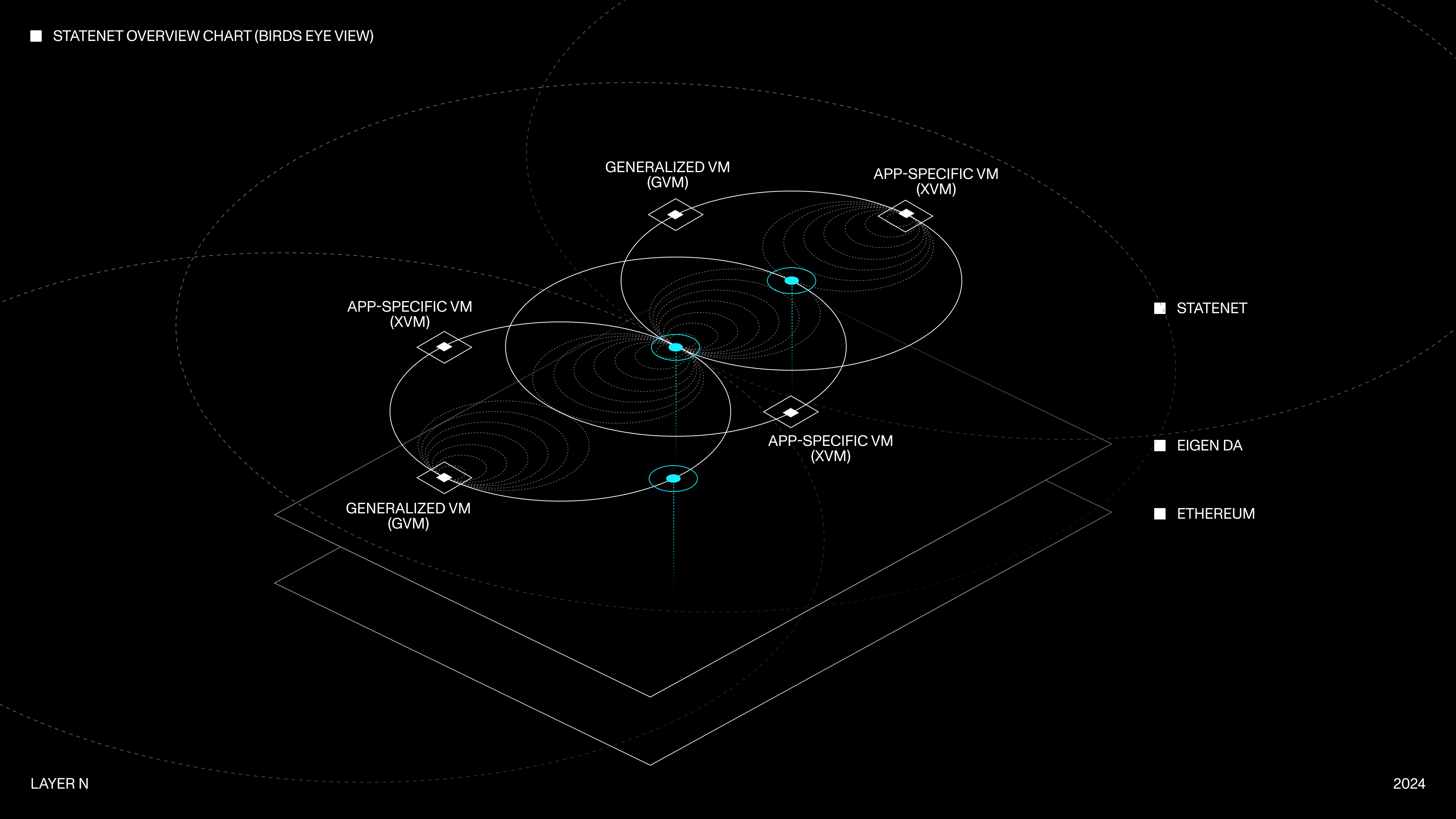StateNet Overview
Layer N is an Ethereum StateNet—A network of XVMs that share a communication and liquidity layer. The StateNet is a form of layer 2 design that enables both generalizable VMs (like the EVM) as well as highly optimized, complex and application-specific VMs to seamlessly integrate and share liquidity between each other. The term StateNet comes from the idea of an entire system's State diffused throughout a Network of VMs.
There are 2 fundamental axis of thinking behind the design of the StateNet. I) for on-chain applications to compete with modern centralized systems, on-chain infrastructure needs to be just as fast, cheap and reliable. The StateNet achieves this through enabling application-specific VMs that can run highly optimized and complex execution engines. II) To create a sprawling on-chain ecosystem and environment, these applications need to be able to natively integrate, compose, and share liquidity with each other. The shared communication and liquidity layer of the StateNet enables this without the risk and cost of using third party bridges, or complex proof systems.

How the StateNet works
At a high level, the StateNet is an orchestration of multiple VMs that share a common communication protocol. The StateNet leverages higher bandwith off-chain Data Availability solutions to maximize performance, all while settling state and running proofs on Ethereum.
Solving performance
Layer N enables the development of highly specialized application-specific VMs (XVMs). This specialization enables applications to have their own compute environment and bandwith, meaning developers can run highly complex logic without worrying about gas costs, and performance (think of it similarly as running a program on an isolated server vs a shared server). Nord Engine is an example of an ARN. Nord Engine is optimized for trading and mirrors the architecture of modern financial exchanges.
Layer N XVMs are also fully built in Rust for maximum execution performance. Building in Rust is made possible by leveraging RiscZero for ZKFPs that support the RISC-V instruction set. Layer N only generates ZK proofs when necessary (i.e. in the event of validator fraud)—unlike typical zkrollups that require constant proof generation which is an extremely costly overhead. Event-driven usage of ZK proofs offer two key benefits: web2-like performance and shorter fraud-proof windows than traditional optimistic rollups.
Solving throughput
Another significant bottleneck that plagues existing blockchain infrastructure is the blockspace issue. Most rollups today use Ethereum's blockspace to store transaction data, driving transaction prices for all rollups extremely high, rendering it a very cost-inefficient development path. The growing competition for blockspace and the scarcity of available blockspace makes it impossible to run modern applications like Coinbase fully on Ethereum.
Layer N leverages EigenDA, a novel solution providing megabytes of blockspace per second. EigenDA is also secured by Ethereum validators through restaking. Unlike existing blockchains that have fixed capacity regardless of the number of validators, EigenDA scales its capacity horizontally as it brings on more validators. This innovation effectively overcomes the conventional bandwidth constraints inherent to blockchains, enabling Layer N to scale horizontally and maintain significantly lower transaction fees, and much higher throughput.
Some Layer N XVMs also employ signature aggregation techniques that compress data by a factor of 8-10x, resulting in even lower transaction fees.
Solving connectivity
The final key to making everything function seamlessly is a shared communication and liquidity layer that connects all applications together: the Inter-VM Communication protocol (IVC). IVC enables every XVM and application to seamlessly transmit messages to other XVM and instantly bridge liquidity. To the end user, it becomes imperceptible on which Layer N XVM they are using. They will be able to use applications without being concerned about the intricacies of bridging. Layer N XVMs submit their state updates to the same contract. As such, all Layer N XVMs can be viewed as components of one large state machine, unconstrained by computational limits or space restrictions.